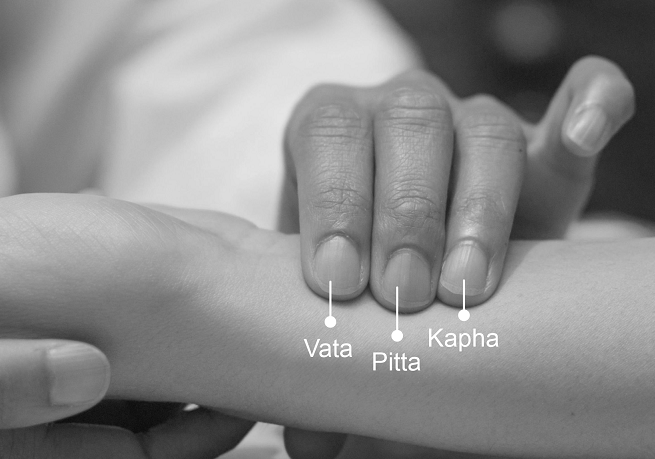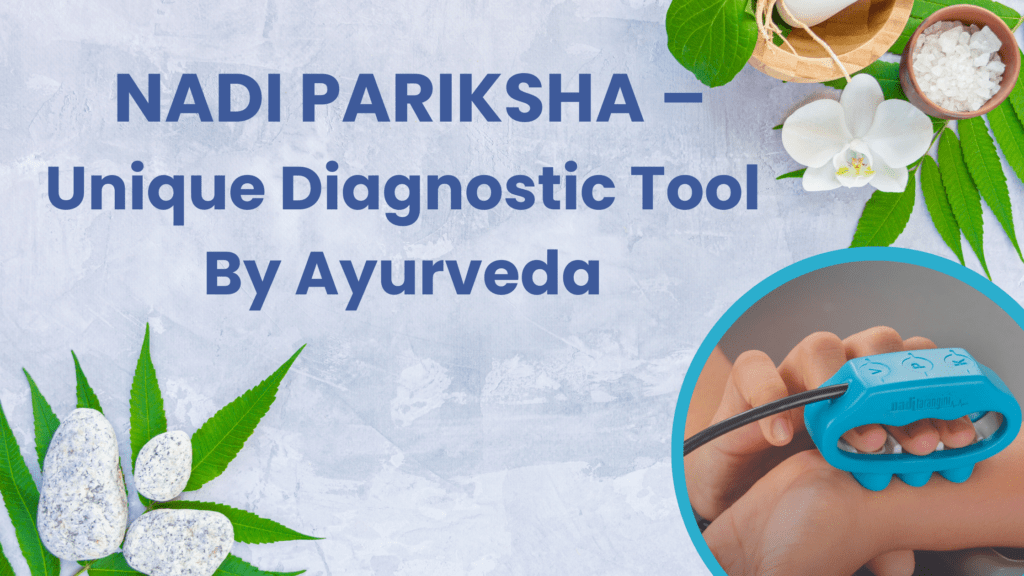Ayurveda is well known for Nadi Pariksha and classical texts have emphasized its significance in assessment of Tridoshik imbalances within the body which are the basis of various diseases in the body. It can accurately diagnose physical, mental and emotional imbalances as well as diseases.
Nadi Pariksha is a non-invasive technique of diagnosis that can give more insights about underlying pathogenesis and can provide more information about prognosis and prediction of the disease. Nadi Pariksha enables us to reach the root cause of health issues and not just address the symptoms.

More about Nadi Pariksha Shastra –
Ayurveda focuses on Ashtavidha pariksha including examination of pulse, urine, faeces, eyes, tongue, speech, skin and body physics for diagnosis.
According to Yoga Ratnakara all the diseases can be diagnosed from Nadi Pariksha.
Nadi Pariksha was initially identified in the books of Sharangdhar Samhita in the 13th century highlighting the correlation between Nadi and Tridosha. Later, in the 16th century it was again mentioned in ‘Bhavprakash’ scripted by Shri Bhav Mishraji.
However, Nadi Pariksha gained its significance during the 17th century in Yoga Ratnakar through 48 shlokas, detailing the science of Nadi. The scripture highlights details such as the appropriate time for Nadi Pariksha, rules for the Vaidya or Ayurvedic physician as well as the patient and also the rules to be followed before and after Nadi Pariksha.
Nadi Pariksha understands the vibratory frequency of the pulse at various levels on the Radial artery. Subtle vibrations are read at three different points below the root of the thumb which help in ascertaining various functions in the body. The Nadi, when examined, reveals both physical & mental characteristics of the patient. This is interpreted in the form of symptoms along with their prognosis, which helps in understanding the cause. Thus, Nadi Pariksha forms the basis for addressing any ailment in an individual. Additionally, it is also the scientific tool that enables an individual to secure their personalized wellness regimes that range from therapeutics, personalized diet, exercise programmes, rigorous detoxification and lifestyle modifications.
Nadi Pariksha is conducted by a trained Ayurvedic practitioner who employs a specialized technique to assess the pulse. Unlike conventional pulse-taking methods, which primarily focus on the rate and rhythm of the pulse, Nadi Pariksha involves a comprehensive analysis of various pulse characteristics. These include Strength (Bala), Velocity (Gati), Rhythm – regularity or irregularity of the pulse beats, Consistency etc.
Methodology Of Nadi Pariksha –
- For precise diagnosis, it is recommended that the diagnosis be done on an empty stomach, early in the morning or three hours after food. The reason behind this principle is food metabolism processes have impacts on Nadi.
- The hand of the patient should be free and slightly flexed at the forearm. 3 fingers of the hand namely the index finger, the middle finger and the ring finger of the physician gently touches the skin over the radial artery. The index finger is comfortably placed nearest the thumb and the other two fingers are placed next to it (the thumb should not be extended too far nor too much fixed).
- There is a precise description of dosha predominance in the texts which can be sensed from specific locations on radial artery and accordingly Vata dosha is felt at the root of the thumb which can be sensed with index finger, next to it is Pitta dosha which can be sensed with middle finger followed by Kapha dosha sensed by ring finger.
- Through a combination of palpation techniques and intuitive assessment, the Ayurvedic practitioner discerns subtle variations in these pulse characteristics, which provide valuable insights into the individual’s physical and psychological state.
Characteristics of a pulse in a healthy person –
The pulse of a healthy person is steady and forceful. It beats like Hansagamana (the movements of a swan) and Gajagamini (the walking of an elephant).
Nadi Gati (movement of the pulse) and their relationship with Dosha –
- Vata dosha: Jalauka and Sarpagati – The pulse moves like a leech or snake.
- Pitta dosha: Kulinga-kaka-Manduka gati – The movement of the pulse is like a sparrow, crow, or frog.
- Kapha dosha: Hansa and Paravata gati – The movement is like a swan or pigeon.
- Vata-Pitta dosha: Muhur sarpa gati and Muhur beka gati – The pulse sometimes moves like a snake and sometimes like a frog.
- Vata-Kapha dosha: Sarpa – hansa gati – The pulse sometimes moves like a snake and sometimes like a swan.
- Pitta-Kapha dosha: Hari-hansa gati – The pulse sometimes moves like a monkey and sometimes like a swan.
- Sannipataja or Tridoshaja: Lava-tittira-vart gamanam – The pulse movements are like a bustard quail, grey partridge, or button quail.
- The dosha predominance can be well assessed with Nadi which is a very unique way of diagnosis in Ayurveda wherein the movement of the pulse has been compared with the movement of animals, birds and reptiles.
Key considerations while performing Nadi Pariksha –
The speed, stability etc parameters of the pulse vary with the aggravated doshas and assessing such variations with Nadi Pariksha is an art and science of its own. Ayurveda has rich experience in pulse-based diagnosis but it is subjective in nature and is highly dependent on skill of the physician.
There are many parameters related to Nadi Pariksha which are described in Ayurveda. Gati (movement), vega (rate), tala (rhythm), bala (force), tapamana (temperature), akruti (volume and tension) and kathinya (consistency of the vessel wall) across vata, pitta and kapha doshas are very tricky to assess.
Current advances in Nadi Pariksha –
Nadi Pariksha is a well established diagnostic tool and has significant impacts in managing health. Nadi Pariksha is one of the traditional methods of performing health assessment in a non-invasive way. It is an extraordinary assessment tool and a boon in the field of the healthcare sector.
In this fast-paced world where everything has to be ultra-efficient, Nadi Tarangini is an unparalleled technological advancement which can assess Nadi incorporating Ayurvedic principles.
Nadi Tarangini auscultates subtle changes in overall health parameters based on Vata, Pitta and Kapha (Tridosha) by analyzing Nadi.
As per classical texts, qualities or properties of Nadi / pulse such as pulse movement (Gati), speed of the pulse (Vega), stability of the pulse (Sthiratva), and hardness of the artery (Kathinya) play a major role in Nadi Pariksha. The classical texts emphasize the significance of Gati, a unique quality of the Nadi as part of Nadi Pariksha. These all parameters can be assessed by Nadi Tarangini via sensor based patented technique through digital Nadi Pariksha.
Nadi Pariksha along with metabolic health and emotional well-being can be monitored and analyzed digitally by Nadi Tarangini. A report mentioning all minute parameters is generated that is a unique individual-specific health assessment card. The report can be assessed and co-related with associated complaints and it could be used for follow-up too. It is a simple, non-invasive technology that enables us to reach the root cause of health issues in a personalized manner and not just address the symptoms.
This is a perfect blend of ancient Ayurveda wisdom and technology that focuses on good QoL- Quality of life for everyone’s well-being.
